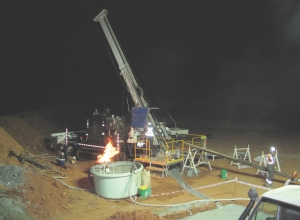Vancouver — Visible gold has been found in high-grade inter- sections at ATW Venture’s (ATW-V, ATWVF-o) Burnakura project in Western Australia.
ATW is refurbishing the old infrastructure and developing new underground workings at Burnakura, which is in the West Yilgarn goldfields. The company is targeting production for March 2009 and plans to produce 35,000 oz. gold annually.
A recent 20-hole drill program designed to extend the NOA 2 deposit to the north and downplunge has done one better: results indicate the presence of a new ore zone within access of the current underground workings.
The latest strong intercept came from hole 12: 16 grams gold per tonne over 23.7 metres, including 51.65 grams gold over 6.5 metres, from 123 metres down-hole.
Three other drill holes reported in the same news release also hit the new zone but returned only short intercepts. For example, hole 7 cut three intercepts: 0.5 metre grading 1.54 gram gold, 0.5 metre of 1.48 grams gold, and 1 metre of 1.21 grams gold.
In mid-September, ATW announced the first results from this new zone, which were more consistent. Intercepts included 15.6 metres grading 13.37 grams gold, 4.3 metres of 5.92 grams gold, 3 metres grading 12.78 grams gold, 7.5 metres of 10.93 grams gold, and 4.5 metres grading 9.09 grams gold.
The new zone is 6 to 25 metres in apparent width, with gold mineralization confined to the diorite that hosts quartz vein stockwork. It is open in all directions; ATW is now drilling updip. The company is also revising its mine development plans to incorporate the area early on in mining, since the zone exhibits grades that are roughly 60% higher than the average grade in the NOA 2 deposit.
The project is home to a fully permitted carbon-in-leach (CIL) gold plant that can process 160,000 tonnes per year, as well as rolling stock, underground equipment, and a 90-man camp. ATW has finished rebuilding the crushing circuit and is now refurbishing the plant and building a gold recovery room.
The project comprises 15 historical open pits along a 12-km mesothermal shear zone. Historical mining concentrated only on oxidized mineralization.
ATW’s share price had fallen 10 before the company announced the results from hole 12. Following the news, its share price rebounded; it closed the day up a penny, at 44.5. ATW has a 52-week trading range of 27-$1.28 and has 58.5 million shares issued.
ATW’s other major project is the Gullewa gold-copper project, 450 km north of Perth in the Yalgoo mineral fields of Western Australia. ATW purchased Gullewa from Batavia Mining (BTVMF-O, BTV-A) for 2 million shares and a total of A$13 million in staged payments, in a deal that closed in July.
The main deposit at Gullewa is Deflector, which hosts measured and indicated resources of 1.7 million tonnes grading 4.18 grams gold, 6.87 grams silver per tonne and 1.03% copper. Inferred resources add 1.6 million tonnes grading 6.5 grams gold, 3.41 grams silver and 0.48% copper.
Now ATW thinks it has found indications that Deflector still has room to grow. The company conducted a gravity survey on the property that identified a potential extension stretching 1.8 km north and another extending 900 metres south. Previously, it was thought that Deflector was closed along strike.
ATW says analysis of the gravity survey results in conjunction with historic magnetic and induced-polarization data shows that previous drilling to the south and north did not penetrate deep enough to test Deflector’s extensions.
The company plans to first test the 900 metres of potential expansion that lies to the south and downplunge of the current deposit. Drills will then move to test the northerly prospect.
Mineralization at Deflector consists of steeply dipping quartz veins with pyrite, chalcopyrite, and pyrrhotite. Veins vary in thickness from 1 to 5 metres. The Deflector deposit is currently delineated along 900 metres strike.
Gullewa came with a 300,000- tonne-per-year CIL plant, a licensed tailings disposal facility, and a 50- person camp.


Be the first to comment on "ATW hits VG in new Burnakura gold zone"